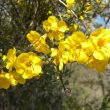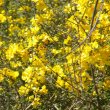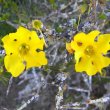| Botanical Name |
|
| Family |
Bignoniaceae - The jacaranda family. |
| Pronunciation |
rye-GOH-zum ob-oh-VAY-tum |
| Common Name(s) |
English: Yellow pomegranate; Karoo Gold
Afrikaans: Geelberggranaat; Ystervarkbos
|
| Plant Group |
- Shrub A woody plant of relatively low height, having several stems arising from the base and lacking a single trunk; a bush.
|
| Plant Size |
- Large
| Tree | 18m to 25m |
| Shrub | 3m to 4m |
| Perennial/ground cover | 75cm to 1m |
| Bulb | 80cm to 1.2m |
| Succulent | 1m to 1.5m |
- Medium
| Tree | 10m to 16m |
| Shrub | 1m to 2m |
| Perennial/ground cover | 40cm to 60cm |
| Bulb | 40cm to 60cm |
| Succulent | 40cm to 60cm |
|
| Position |
- Partial Shade The area is in shade for part of the day and in full sun for part of the day.
- Sun The area is in full sun for all or most of the day, all year round.
|
| General Information |
- Deciduous Plants which completely lose their foliage for part of the year.
- Drought Tolerance: High The plant is well adapted to arid conditions; it can survive long periods of drought and high temperatures without extra water.
- Frost: Hardy The plant can withstand freezing temperatures or frost without artificial protection.
- Roots Non-invasive Safe to plant near pools, paving, walls or buildings.
- Thorns / Spines / Prickles Thorn: A hard, woody, pointed branchlet.
Spine: A modified leaf forming a hard, sharp-pointed outgrowth.
Prickle: A small, sharp-pointed outgrowth growing from the bark of the plant.
- Water Wise Plant species originating from low rainfall regions that require less water to survive and thrive than other plant species.
|
| Specific Information |
This is a densely branched shrub or small tree with grey-green leaves and short, stubby spines. In the wild the shrub responds to spring rain at which time it flowers. The bright yellow flowers appear en mass before the leaves, followed by the fruits - flattened, pod-like capsules that give the bush a pinky-brown tint as they ripen. It is best positioned at the back of smaller shrubs so that its woody, tangled base is hidden from view. An excellent choice for arid regions. The spiky growth form makes it suitable as a barrier.
|
| Ad Break |
|
| Flowers |
| Description |
tubular with 5 lobes, 3-5cm in diameter
|
| Season |
- Spring Plants will seldom bloom for the entire season as given in the list, but should flower during a period within these parameters.
|
| Colour |
|
| Growth Rate |
- Slow to Moderate Specifying growth rate can be very misleading as there is considerable variation of growth rate depending on type and species of plant, available water, supplementary feeding, mulching and general care, as well as the plants suitability and adaptability to the garden environment.
|
| Plant Uses |
- Attracts bees, butterflies or other insects This plant attracts insects which can be food for birds or other creatures in your garden.
- Barrier Plant A very thorny shrub, tree or scrambler that can be used to create an impenetrable barrier.
- Boundary A plant useful for planting around the edges of the property to form a green or colourful backdrop, an impenetrable hedge, to hide walls or create privacy.
- Filler Either a fast growing tree or shrub used temporarily to fill in an area while the permanent plants grow to a desired size, or a plant used to fill gaps in borders or beds.
- Rock Garden An area constructed of larger rocks, arranged naturally, to emphasise the use of stones as a main element. Generally plants used do not need a lot of care.
- Wild Garden An indigenous garden planted for the benefit of wildlife and birds. Provides food, water, a variety of mini-biomes and no poisonous chemicals are used.
|
| Distribution and Habitat |
in the Northern, Western and Eastern Cape, Free State, Mphumamalanga and Namibia, on rocky outcrops and hills in semi-arid regions.
|
| Planting Suggestions |
Although the yellow pomegranate can withstand dry conditions and neglect, for best results add compost the soil. Plant it in a sunny spot in well-drained soil. Do not over-water.
|
| Medicinal Uses |
The fruit and the leaves are eaten by stock and game but no evidence of medicinal use has been found.
|
| Ad Break |
|








Comments
Rhigozum obovatum
Questions: suitability for bonsai?:has anyone tried propagation from truncheons or shoots?: if so use of growing hormones and watering techniques?
Hi Ian
Hi Ian
There is little information available about this plant as it has no medicinal use and has not been developed either as a garden plant or for agricultural use. I have no personal experience with it as the only seeds I could obtain were infested. All I can tell you is my own impression, based more on instinct and observation than fact.
I doubt its usefulness for bonsai. It is very woody, is relatively short-lived and consists of a great deal of twiggy growth. I have a strong feeling that, like other similar woody shrubs I have experimented with, it will not respond well to pruning.
It may grow from shoots but any branch as stout as a truncheon - if you can find one - is likely to be very dry. Using a growth hormone for cuttings would be a matter of experiment to see what works, as would be the watering thereof.
Apologies for not being able to give you more useful information. If you do experiment with this species, I would really appreciate it if you would let me know of the outcome.
Kind regards
Lorraine
Discuss this plant
Share knowledge, ask a question or give an experience.